It has been so rewarding to hear feedback about the many benefits of the Story Massage Programme for autistic children. Benefits include relaxation, touch tolerance, emotional regulation, increased concentration, better sleep and social connection.
Communication Skills
The ten Story Massage strokes can be adapted to meet the needs of individual children and can be given sitting, standing or lying down. As Sensory Leader at Ysgol Y Deri, Lisa Lawrence, says sharing massage as a face to face activity is best children who find communication difficult. “The combination of words and massage strokes helps children to relax and you begin to gain eye contact and develop communication skills,” says Lisa, “We encourage the children to vocalise or use body language and smiles to show which different massage techniques they like the best.”
Vocabulary and Expressive Language
At Kiladangan National School in Tipperary, the Story Massage Programme was introduced by Holistic Therapist, Melanie Kelly and is now part the Literacy Curriculum for autistic children.
“Within a few months of regular weekly sessions we have seen a marked improvement in expressive language and vocabulary,” says Avril Mounsey, Class Teacher, “The Story Massage Programme literally brings words to life for our pupils and makes learning a more enriching and beneficial experience for everyone. Our pupils now have the ability to distinguish between verbs, nouns and adjectives, and this is a real achievement.”
Improved Concentration
The Story Massage Programme can provide a fun way of encouraging concentration and on-task behaviour. “This term I have incorporated the programme into my daily literacy sessions for autistic young children,” says Cesci Aromas White, Senior Leader in ASD at St Joseph’s School in Surrey, “The positive impact on concentration and engagement has been incredible. One young boy has always really struggled with story time but he has started asking for ‘more’ since I introduced the programme. It is wonderful to see how much it has helped the children learn to concentrate and focus their attention.”
Readiness for Learning
Going back to class after lunchtime play can be difficult for many children, especially autistic children. At Woodbank Special School in Halifax, the Story Massage Programme is now being used to help children relax and regulate their emotions so they are ready for learning.
“We began sessions on one young boy who found it really hard to regulate and calm himself after lunchtime play,” says Tracy Greenwood, Specialist Teaching Assistant, “After only one session, he was much calmer and willing to go back into the class. I chose a familiar story and used deep pressure moves which we know can help him regulate. He was fully engaged for 20 minutes and stayed relaxed when the session was over. At one point, he gave fleeting eye contact and even snuggled into my neck which was a real ‘wow’ moment as he does not usually like being so close to anyone.”
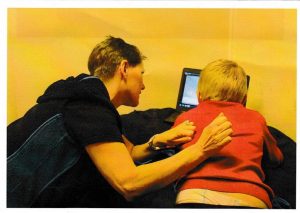
Reduced Anxiety
Autistic children can experience a high base level of anxiety every day. And unexpected events can escalate their anxiety so that it becomes overwhelming and may lead to challenging behaviour.
“An example was the impact of the terrorist attacks in the UK on our pupils,” says Karen Horner, Specialist Autistic Practitioner at a nurture unit in a school in Northumberland, “One young boy, in particular, was extremely anxious and frightened about going out. I wrote a massage story to help him understand that whilst bad things happen, there are many people who love him and keep the world a safe and happy place for him. It really helped to calm him down, and he kept asking for it because it felt safe. The Story Massage Programme helps release ‘feel good’ hormones in brain acting with the parasympathetic system and this helps calm the nervous system.”
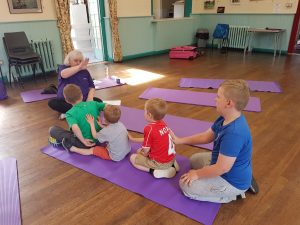
Social Interaction
Many autistic children tend to work individually and can be averse to giving and receiving touch. The Story Massage Programme was introduced to a group of 14 autistic children, both girls and boys, at Orchard Primary School in Wisham to see if to see if it would encourage social interaction through peer massage – and it did.
“Within four weeks of sessions, twice a week, the children were working on each other,” says Audrey Clemenson, teacher in the LCSC (Language and Communication Support Centre). “Before the children can work or play together, they need to be able to relate to one another first. I’ve been teaching relating skills with my class and the Story Massage Programme fits into this beautifully. We began by encouraging them to do the strokes on themselves, and then we introduced favourite stories. We are so thrilled to see how they massaging each other in pairs and we hope this social interaction will extend to other areas of their lives. It is a big step for our pupils.”
Preparation for Change
Children can find it challenging to cope with any change – and starting a new class away from home and familiar surrounding can be particularly difficult. Staff at The Snowflake Centre, based in New Bridge Nursery School in Reading, use the Story Massage Programme for children with autism to prepare them for mainstream nursery and mainstream school. But it is not just about preparing for transition to a new school or class. Social stories combined with the ten basic strokes are now widely used to prepare children for any change to their usual routine and help them make sense of the world around them.
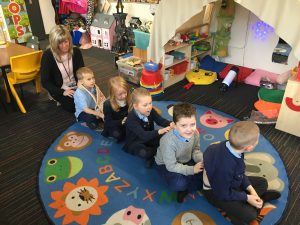
Addressing Challenging Behaviour
The combination of story and massage techniques can be very effective in coping with challenging behaviour, says Katrina Payne, a Sensory Therapist working with a range of clients with additional needs.”The Story Massage Programme offers the distraction of creativity and use of the child’s imagination, ” One example of this is where a child initially only wanted ‘scratching’ on his skin, he was constantly scratching his own skin.”
“By incorporating a bit of ‘scratching’ using The Claw stroke on his forearms during a story, I was able to introduce other strokes to add to the sensory experience of touch. He became more relaxed and willing to wait for longer periods for ‘scratching’ to occur. Eventually, the story itself and its positive touch experience replaced the need to be so obsessive about the scratching sensation. He was then able to move on to enjoy therapeutic massage which gave him a relaxation activity he wasn’t able to access previously. It was introducing the Story Massage Programme that made all the difference.”
Learning mentors at the Pupil Referral Unit (PRU) in Brighton have found the programme offers a positive intervention following restraint of more challenging pupils. “It is hard for both adult and child to feel positive towards each other after a restraint,” they explain, “So once the child calms down, we maintain the contact and do a massage story using the firmer strokes. This means that we come out of the restraint in a calm and more connected way. We both end up feeling better about the situation.”
Touch Tolerance
Touch aversion can be a real issue for parents and those working with autistic children and those with sensory processing disorders. “The Story Massage Programme is an alternative idea for children to get used to positive touch,” says Helen Edgar, Special Needs Teacher at a school in Birmingham, “We find that some children prefer and tolerate some strokes more than others, so we adjust the activity to suit children’s individual needs. We use familiar stories that we repeat on a regular basis so the children can begin to anticipate events in the story and the different strokes. Gradually children begin to relax and enjoy the session. It is a wonderful way of introducing children to the pleasure of positive touch and developing relationships and trust.”
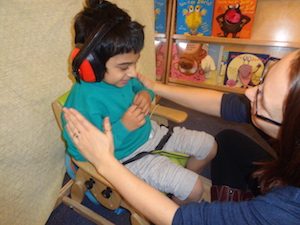
Better Sleep
At Westfield Special School in Leominster, the Story Massage Programme is now a regular part of the daily routine as it had made such a positive difference to the children. Nicky Morris, Class Teacher in Hedgehog Class, says that helping one boy to sleep at night has made such a huge difference to the whole family that she would list improved sleep as a key benefit. Nicky Morris runs regular sessions in class and encourages parents to continue at home. “This particular boy was having real problems with sleep, but with a regular massage story at bedtime from his parents, he is more relaxed and is now sleeping through the night,” says Nicky.
More about the Story Massage Programme
The Story Massage Programme combines the benefits of positive touch with the creativity of storytelling. Ten massage strokes form the basis of the programme. These strokes have a simple such as The Circle or The Sprinkle, and an easy to recognise symbol making it fully accessible for all ages and abilities.
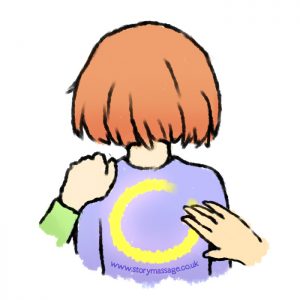
Would you like to train in the Story Massage Programme?
Are you inspired by the benefits of the programme for autistic children? Would you like to train to share massage stories in your work or home? We run a popular online training course to teach you how to share the ten Story Massage strokes and use them adapt familiar stories or even create some sensory stories of your own. Ideal for Early Years practitioners, teachers, therapists, those working with people with additional needs, Relax Kids coaches… everyone with an interest in sharing positive touch activities with children. All the information is here: Story Massage Programme Online Training.
